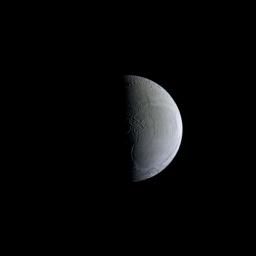Frozen in Time
Caption:
NASA's Cassini captures a still and partially sunlit Enceladus. The Saturnian moon is covered in ice that reflects sunlight similar to freshly fallen snow, making Enceladus one of the most reflective objects in the solar system. The blue color in this false-color image indicates larger-than-average ice particles. The moon's surface is decorated with fractures, folds and ridges caused by tectonic stresses. For more about the tectonics on Enceladus see
PIA11686
.
This view looks toward the side of Enceladus (313 miles or 504 kilometers across) that faces backward in the moon's orbit around Saturn. North on Enceladus is up. The images were taken with the Cassini spacecraft narrow-angle camera on April 7, 2010, using filters sensitive to ultraviolet, visible and infrared light (spanning wavelengths from 338 to 750 nanometers).
The view was acquired at a distance of approximately 123,000 miles (198,000 kilometers) from Enceladus. Image scale is 3,889 feet (1 kilometer) per pixel.
Background Info:
The Cassini-Huygens mission is a cooperative project of NASA, the European Space Agency and the Italian Space Agency. The Jet Propulsion Laboratory, a division of the California Institute of Technology in Pasadena, manages the mission for NASA's Science Mission Directorate, Washington, D.C. The Cassini orbiter and its two onboard cameras were designed, developed and assembled at JPL. The imaging operations center is based at the Space Science Institute in Boulder, Colo.
For more information about the Cassini-Huygens mission visit
http://saturn.jpl.nasa.gov
and
http://www.nasa.gov/cassini
. The Cassini imaging team homepage is at
http://ciclops.org
.
Cataloging Keywords:
| Name |
Value |
Additional Values |
| Target |
Enceladus |
Saturn |
| System |
Saturn |
|
| Target Type |
Satellite |
Planet |
| Mission |
Cassini-Huygens |
|
| Instrument Host |
Cassini Orbiter |
|
| Host Type |
Orbiter |
|
| Instrument |
Imaging Science Subsystem (ISS) |
|
| Detector |
Narrow Angle Camera |
|
| Extra Keywords |
Color, Infrared, Ultraviolet, Visual |
| Acquisition Date |
|
| Release Date |
2013-12-23 |
| Date in Caption |
2010-04-07 |
|
| Image Credit |
NASA/JPL-Caltech/Space Science Institute |
| Source |
photojournal.jpl.nasa.gov/catalog/PIA17181 |
| Identifier |
PIA17181 |

 Planetary Data System
Planetary Data System
